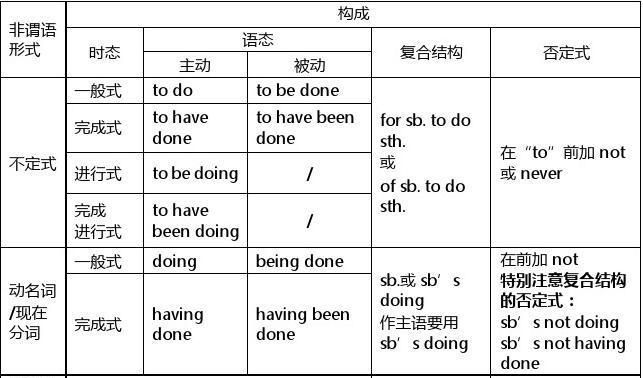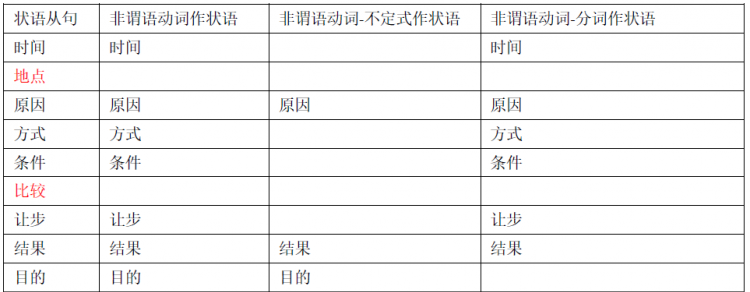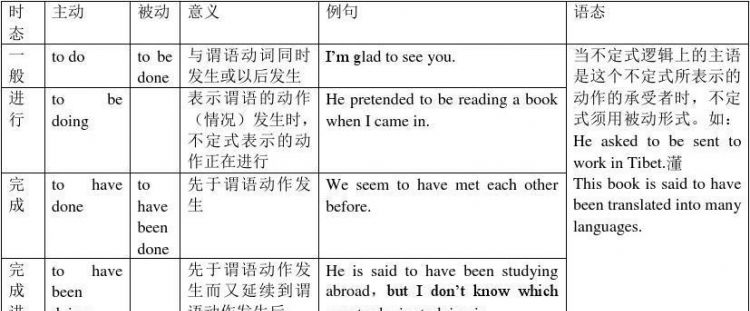本文目录
非谓语做状语的用法例句
非谓语做状语的用法:非谓语动词有三种形式:不定式,分词和动名词;不同形式的非谓语动词其作用各有不同,可以作主语、作表语、作状语、作定语、作补足语等。
一、不定式作状语的用法:
1、作目的状语,意为“为了”。例句:To pass the college entrance exam, we must work hard.

2、作结果状语,不定式作结果状语常表示令人意外的结果。例句:I went to see him last night only to find him out.
3、作原因状语,常用在表示情感或态度的形容词后,如“sorry, surprised, disappointed”等,常用结构为“主语+系动词+形容词+to do”。例句:Tom was very happy to see his mother.
二、分词作状语的用法:
1、作时间状语。例句:When completed, the road will be open to the public.
2、作原因状语。例句:Not understanding this, he asked the teacher about it.
3、作条件状语。例句:u Working hard, you’ll succeed.
4、作结果状语,常用现在分词表示自然而然的结果。例句:The fire lasted nearly a month, leaving nothing valuable.

5、表方式或伴随状语:例句:The teacher came into the lab, followed by some students.
三、独立主格结构作状语:名词/代词+非谓语动词。Weather permitting, we will go swimming.
非谓语作状语的句子
特征是句子中已经有了谓语动词,并且没有连词。
非谓语动词指的是在句子中不做谓语的动词,主要包括不定式、动名词、现在分词和过去分词。如果句子中已经有了谓语动词,并且没有连词,那么其他的动词就需要用非谓语形式。可以做状语的非谓语形式有动词分词、不定式。
状语(adverbial)是句子的重要修饰成分,是谓语里的另一个附加成分,它一般附加在谓语中心语前面。

非谓语动词作状语的用法总结
非谓语动词形式有以下集几种:不定式(短语),现在分词(短语),过去分词(短语)
不定式作状语可以用来修饰动词,说明目的,结果,原因,程度;修饰形容词,帮助说明它的意义;修饰整个句子,表示说话人对所说的话抱的态度,或其他东西
We
will
go
to
the
airport
to
meet
our
friend.()
What
have
I
done
to
surprise
you
so
much?
()
I
feel
sad
to
hear
the
bad
news.()
I'm
not
cleve
enough
to
answer
the
question.()
I
found
the
book
very
interesting
to
read.()
现在分词短语作状语,可表示1
行为方式或伴随发生的情况
He
came
downstairs
waving
to
us.
2
时间Seeing
this,
the
teacher
looked
worried.
3原因:
Not
having
enough
time,
we
have
great
difficulty
in
completing
the
work.
过去分词短语作状语1
动作发生时的背景或情况
Encouraged
by
the
teacher,I
decided
to
learn
English
well.
2
原因
Moved
by
his
speech,
we
didn't
know
what
to
say.
3时间Sent
to
this
school,the
boy
has
made
great
progress.
4条件
Taken
in
time,
the
medicine
will
be
quite
effective.
主要就是这些。

非谓语动词作状语的用法总结
非谓语动词作状语用法详解
作状语是非谓语动词的主要功能之一。正确运用非谓语动词作状语是考生必须掌握的最基本英语语法知识之一,也是NMET及其同等水平考试常见考查内容。笔者这里结合一些常见例题谈谈此方面语法知识的复习。
一、不定式作状语
不定式作状语常常考查的有以下三方面知识:
⒈不定式作目的状语 一方面不定式可以独立作目的状语;另一方面不定式还可以用在so as (to) 或 in order (to) 后,表示目的。从结构上讲,不定式作目的状语放于句首时,通常用逗号和句子隔开;如果放于句末,通常不用逗号:
【名题1】 (2003北京海淀区高三第二学期期中练习 · 26)
_____ their service, the workers of the hotel are active in learning English.
A. Improving B. To improve C. Improved D. Having improved
【解析】 本题考查非谓语动词作状语。不定式放于句首,说明了酒店员工积极学习英语的目的。答案为B。
【名题2】 (2003北京东城区高三总复习练习(一)· 26)
______ time and labour, cartoonists generally draw the hands of their characters with only three fingers and a thumb.
A. To save B. Saved C. Saving D. Having saved
【解析】 本题考查非谓语动词作状语。不定式放于句首,说明了漫画家在画人物的手指时为什么只画三个手指和一个大拇指。答案为A。
【名题3】 (’99SHMET · 18)
—Mum. Why do you always make me eat an egg every day?
—_______ enough protein and nutrition as you are growing up.
A. Get B. Getting C. To get D. To be
【解析】 本题考查非谓语动词作状语。分词作状语可以表示时间、原因、条件、伴随情况;不定式作状语多表示目的和结果。问句以why 开头,暗示了要用非谓语动词作目的状语。作目的状语的不定式可用in order to 来引起;有时为了强调,也常常放在句首。答案为C。
2.不定式作结果状语 不定式作结果状语时放于句末,其前面时常有副词only(In the last analysis or final outcome:—最后的分析,最终结果:):
【名题4】 (2004陕西省高三调研题 · 27)
The American troops tried many times to break into the mosque, _______each time.
A. beaten back B. only to be beaten back
C. being beaten back D. having been beaten back
【解析】 本题考查动词不定式作结果状语。A项为过去分词,其基本属性是表示“一个早于谓语动词而发生的被动动作”,通常说明谓语动词发生背景;C项为现在分词的被动体,其基本属性是表示“一个和谓语动词同时发生的被动动作”,但这种形式一般不用于作状语;D项为分词完成体的被动形式,用以强调该被动动作在位于发生之前已经完成。答案为B。
3.不定式作原因状语 用作原因状语的不定式一般放于句末,偶尔也见于句首。说明谓语动作或状态产生的原因:
【名题5】 (2001陕西省高三调研题(一) · 27)
We all jumped with great joy ______ the news that our country would have joined WTO by the end of the year.
A. hearing B. to have heard C. being heard D. to hear
【解析】 本题考查动词不定式作原因状语。现在分词放于句末作状语时,一般要用逗号和句子隔开;根据题干可以看出这里只说明高兴得跳起的原因,而不是动作是否已经完成。答案为D。
不定式的这种用法常见于表示人的心理感受的形容词作表语的句式中。这类形容词常见的有:happy, glad, sorry, lucky, fortunate, unfortunate, ashamed, surprised, frightened, shocked, delighted, disappointed, anxious, impatient, foolish, rude, cruel, wrong, considerate, prompt, etc. 如:
⑴ Many people are eager to take part in the coming Olympic Games.
⑵ We shall be happy to co-operate with you in the work.
⑶ I was annoyed to hear them talk like that.
二、现在分词作状语
使用现在分词作状语时,分词动作的执行者必须是句子的主语。通常有以下三种题型:
1.作伴随状语,表示分词动作同句子谓语动词所表示动作同时进行:
【例题6】 (2002天津市高三模拟试题(二) · 29)
______ the merry tune, Jack fixed the tire.
A. Whistling B. To whistle
C. Whistled D. Having been whistled
【解析】 题干中的the merry tune作非谓语动词的宾语,所以排除表达被动意义的C, D两项;不定式放于句首只能作目的状语;现在分词放于句首时,可以作伴随状语,说明“杰克一边吹这欢乐的小调,一边装这轮胎”。答案为A。
但也有相当一部分只能放句子后面,都可以放:
【例题7】 (2004陕西省高三调研题 · 31)
All night long he lay awake, _______ how to drive the American invaders back home.
A. to think B. thinking C. thought D. being thought
【解析】 现在分词作伴随状语。(译文: 他彻夜未眠,思量着如何把美国鬼子赶回家。)答案为B。
2.作原因状语。例如:
【名题8】 (2003南昌高三测试题 · 26)
______good , the food was sold out soon.
A. Tasting B. Tasted C. Being tasted D. Having been tasted
【解析】 taste 可作系动词,所以没有被动形式。C项是现在分词一般体的被动形式,表示一个和句子谓语同时进行的被动动作;D项是动名词完成体的被动形式表示一个早于谓语动词的被动动作,但动名词不可以作状语。作状语时,如果要表示一个早于谓语动词的被动动作,用过去分词即可。答案为A。
【名题9】 (2004南阳市高三第二次模拟试题 · 34)
—A traffic jam?
—Oh, no. _______, the right side of the road is closed for the time being.
A. To be repaired B. Being repaired C. Repaired D. Having repaired
【解析】 句子的主语是the right side of the road,它和非谓语动词“维修”之间属被动关系,所以排除D;而C过去分词虽然也表示被动,但在时间上却早于句子的谓语;A项虽为被动,但表示的是将来,只说明暂时封闭的目的;B项说明路正在维修,作原因状语。答案为B。
现在分词短语作原因状语,尤其见于be,feel,know,recognize,fear等状态动词的现在分词(短语),以及现在分词的否定式用作状语时。例:
⑴ Seeing the door locked, he realized that he would have to turn back in vain again.
⑵ Not knowing her address, I can’t write to her to express my gratitude to him.
⑶ Not having finished her work, she had to work extra hours.
⑷ They sent us their statement, hoping to get our support.
3.作时间状语,相当于when 引起的从句:
【名题10】 (2003天津市重点中学联考题 · 34)
______the big snake, the little girl stood under the tree _____ out of her life.
A. Seeing; frightened B. Seeing; frightening
C. Seen; frightened D. To see; frightening
【解析】 首先小姑娘看见蛇说明see 和句子的主语是主动关系;C项是过去分词,其根本属性是表示被动,表示一个在句子谓语发生之前已经发生的一个被动动作;D项虽然表示了和主语之间的主动关系,但不定式的根本属性是表示将来。所以,C, D均可排除。而frightened (受惊的)作状语说明了主语受惊后的状态;frightening (令人恐惧的)说明主语的特点。答案为A。
【名题11】 (2004太原市高考模拟试题 · 26)
_______ to her apartment, she found her necklace missing.
A. To return B. Returned C. Being returned D. Returning
【解析】 题中的return意为“返回”,因而不可能有被动形式;不定式放于句首通常只能是作目的状语,因此不和题义。而这里现在分词放于句首相当于一个由when连接的时间状语从句,表示这动作一发生,谓语表示的动作立即发生。答案为D。
如果两个动作是同时发生,多用when或while加分词这种结构,例:
⑴ Be careful when crossing the street.
⑵ When leaving the room, she forgot to lock the door.
⑶ She got to know them while attending a conference in Beijing.
⑷ Don’t mention this while talking to him.
4.如果分表示的动作发生于谓语所表示的动作之前,就用分词的完成体:
【名题12】 (2001NMET · 35)
______ such heavy pollution already, it may not be too late to clear up the river.
A. Having suffered B. Suffering C. To suffer D. Suffered
【解析】 本题考查非谓语动词作状语。按照传统语法,现在分词作状语,其逻辑主语必须和句子的主语相一致,但这里分词的逻辑主语是river(作宾语),又有already 提示“suffer”发生在谓语之前,故用现在分词完成体作状语。答案为A。
【名题13】 (2003广州市高三调研题 · 27)
______a seat, she left her books on it.
A. Found B. Finding C. To find D. Having found
【解析】 根据题义,只有找到座位,才可以把书本放在上面。只有现在分词的完成体D才说明了“find”发生在谓语动作发生之前。答案为D。
三、过去分词作状语
过去分词作状语,用来说明谓语动作发生的背景或情况,通常有以下几种题型:
1.作原因状语,相当于一个原因状语从句:
【名题14】 (2003辽宁省重点中学连考题 · 35)
______ , the young man is healthy and strong..
A. Fully developed B. Fully growing C. Full developing D. Full grown
【解析】 本题考查非谓语动词作状语。首先,分词前要用副词来修饰;其次,grow是不及物动词,可以说grow quickly(长地快)、grow old (变老),但fully growing就不和逻辑了。而develop vt (使发展)。A和句子的主语是被动关系,说明了该年轻人身体强健的原因是因为得到了全面发展。答案为A。
【名题15】 (2004昆明市高三模拟试题 · 28)
______ in thought, he almost ran into the car in front of him.
A. Losing B. Having lost C. Lost D. To lose
【解析】 Lose 是及物动词, 意思是“专心致志于…”, 后接反身代词; lost in thought源于lose oneself in thought。答案为C。
2.表示一个假设情况,相当于一个条件从句:
【名题16】 (2002辽宁省重点中学连考题 · 25)
______ in this way, the situation doesn’t seem so disappointing...
A. To look at B. Looked at C. Looking at D. To be looked at
【解析】 题中的look at 是及物动词,而句子的主语situation 和 look at 只能是被动关系;D项虽为被动体,但不定式放于句首时只能作目的状语,其语法功能和题义不符。答案为B。
【名题17】 (2003太原市高三统一练习题(三) · 30)
_______ with developed countries, we still have a long way to go.
A. To compare B. Compared C. Comparing D. Being compared
【解析】 本句可以转换为复合句“If we are compared with developed countries, we still have a long way to go.”由此得知句子的主语we和compare之间属于被动关系,所以要用过去分词。答案为B。
4. 一般情况下非谓语动词作状语时,要求非谓语动词表示的动作和谓语动词的主语相同,但也有少数分词短语实际上已经成为固定结构,表示说话人对说话内容所持的态度。如:
【名题18】 (2000高考春招 · 17)
______the general state of his health, it may take him a while to recover from the operation.
A. Given B. To give C. Giving D. Having given
【解析】 given在此意为“鉴于”、“考虑到”。这种评说性的独立成分作状语,其逻辑主语不要求和句子的主语保持一致。这种情况下,分词短语的逻辑上的主语和句子的主语是不一致的,可以看作是一种独立成分.例:
⑴ Judging from what you say, he ought to succeed.
⑵ Considering his age, the child reads well.
⑶ Taken as a whole, there is nothing wrong.
⑷ Given their inexperience, they have done a good job.
答案为A。
5. 分词作状语时,有时前面可以加上一个连词。连词than, as, once, if, unless, though, even if等之后,均可以接一个过去分词作状语,这时,分词的逻辑主语是分词的动作对象。
【名题19】 (2002NMET
The research is so designed that once _______nothing can be done to change it.
A. begins B. having begun C. beginning D. begun
【解析】 :本题考查的是过去分词作条件状语从句时的用法.在这儿once begun可换成once it is begun,故最佳答案是D项.
【名题20】 (2002上海春招)
When _______, the museum will be open to the public next year.
A. completed B. completing C. being completed D. to be completed
【解析】该题考查过去分词充当时间状语的用法.同样把when completed还原成when it is completed便可知最佳答案为A.
【名题21】 (2002合肥市高三第二次抽样考试 · 28)
______ who she was, she said she was Mary’s cousin.
A. Asked B. When asked C. When asking D. Asking
例:⑴ Once recovered, he went all out to do his work.
⑵ Though beaten by the opposite team, the players didn’t lose heart.
⑶ If carefully done, the experiment will be successful.
要学习掌握非谓语动词作状语,就必须牢记不定式、现在分词和过去分词的基本属性,并据此从句子的整体结构去理解句子的含义。只有这样,才能有效地排除干扰项,并作出正确选择。

以上就是关于非谓语动词作状语句子,非谓语做状语的用法例句的全部内容,以及非谓语动词作状语句子 的相关内容,希望能够帮到您。
